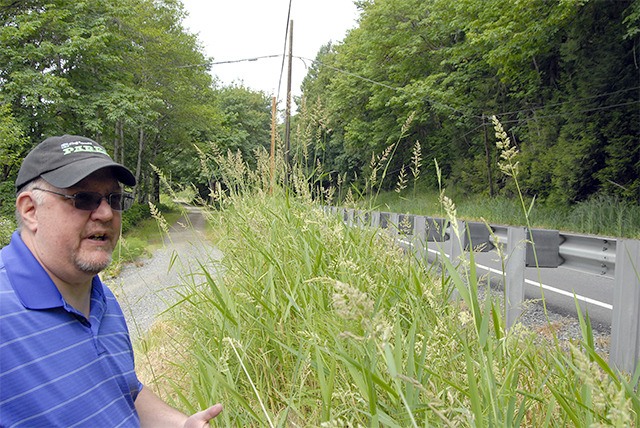Part of the Snoqualmie Valley Trail north of Carnation is officially closed this week, and will be through October. It has to be closed, because right now, a small stretch of it doesn’t actually exist.
The trail, along with trees and brush nearly to the shoulder of State Route 203, disappeared last Friday as contractors and heavy machines set to work on the 150-foot sliver of property encompassing riverbank, trail, state highway and hillside, between Stillwater and Northeast 124th Street.
Their goal is to tear out a failing bank reinforcement, or revetment, and replace it with a steel structure.
Because of the narrow area, Chase Barton, the King County engineer managing the project said there was no feasible way to only partially close the trail. “They’ll actually have to dig out part of the embankment,” he said.
The new revetment, anchored with 131 33-inch-diameter steel piles, 40 to 60 feet long and faced with thick sheet metal, won’t look much like the old one, although the main material used will be the same. According to photos from the Eastside Heritage Center collection, a project to support the riverbank in 1955 used old car bodies as building material. The bodies were inserted along the river across from the Sinnema and Quaale farms and secured with cables anchored into the hillside.
Huge old tree stumps were also used, Barton said, as he led a group on a tour of the project in early June.
“One of the things you can say about farmers is they’re resourceful,” said King County Councilwoman Kathy Lambert, on the tour.
King County has owned the trail, an old railroad bed stretching from Duvall to the Iron Horse State Park trail, since 1977. The trail along the Sinnema Quaale revetment, where the river takes a wide bend, has often been closed for repairs due to erosion over the years, Barton said, and this project aims to address the erosion problem and prevent future emergency closures.
To do that, though, the trail has to be completely closed and, later this summer, the highway will undergo single-lane closures as construction machinery, and those massive piles, move in and out.
“It’s a great challenge because of the close proximity of the river to the hill slope,” said Barton.
The project is centered on a wide bend in the river. Across the water is farm land, owned by the Sinnema and Quaale families when the car-body revetment was installed and named, and some cattle, drinking from and walking in the slow-moving river. On the highway side, cars blur past the trail on the highway, about 10 feet away at its closest point, and you can see a zigzag in the line of the trail to the north.
“The trail has actually slowly had to migrate closer to the highway,” Barton explained, again, because of erosion.
Erosion had also covered up any glimpse of the old revetment that might have been visible through the blackberries and other brush. Well, almost any glimpse.
“I think that’s a steering wheel!” announced Clint Loper, the Snoqualmie Basin supervisor for the Department of Natural Resources, also on the tour.
The wheel, though, was out of reach, and probably not useable as anything other than a project trophy.
Loper said the project, estimated to cost $8.4 million and funded by the county’s Flood Control District and Parks Departments has been a priority since significant flooding in 2006 damaged the revetment, but added “it’s been identified as a need for many years.”
In all, the project will reinforce 750 feet of riverbank and rebuild 1,200 feet of trail that had already begun to “slump” according to county parks property manager Robert Nunnenkamp.
County parks official KK Soi noted that the county went through a public process to inform users of the upcoming closure, and specifically notified several bicycle groups known to schedule rides throughout the Valley in the summers.
Officials are targeting a project completion date of Oct. 31, when the trail would be re-opened.
For more information on the Sinnema Quaale Upper Revetment reconstruction, visit www.kingcounty.gov/environment/wlr/sections-programs/river-floodplain-section/capital-projects/sinnema-quaale.aspx.

These 1955 photographs from the Eastside Heritage Center, above and below, show the construction of the Sinnema-Quaale revetment with old car bodies.


Chase Barton, center, led King County Councilwoman Kathy Lambert and others on a tour of the project site in early June.

The “Car Body Curve” of the Snoqualmie River. The cars, trail and highway are all along the right bank, in this photo.


